Oahu Wind Integration Study - Hawaii Natural Energy Institute ...
Oahu Wind Integration Study - Hawaii Natural Energy Institute ...
Oahu Wind Integration Study - Hawaii Natural Energy Institute ...
Create successful ePaper yourself
Turn your PDF publications into a flip-book with our unique Google optimized e-Paper software.
In parallel with the data collection efforts for the scenario analysis, the project team held several<br />
meetings to develop a strategy to conduct the study. Several decisions allowed the team to<br />
reduce the list of scenarios from five to three. First, the team determined that Scenarios 1 and 2<br />
should be combined to analyze all on-island renewable resources (a potential scenario prior to<br />
construction of the off-island wind plants and HVDC cable system). Second, the team<br />
determined that Scenario 5 should be the first scenario to be considered. It was anticipated that<br />
this scenario could potentially challenge the limits of the electrical system model as well as the<br />
modeling tools, enabling the team to identify constraints and resolve these constraints in the<br />
modeling tools. A successful simulation of Scenario 5 would help to eliminate other scenarios<br />
with smaller renewable energy penetration, such as Scenario 2. This allowed the project team to<br />
focus on analyzing strategies for Scenarios 5 and 3 that could address the challenges of<br />
integrating very high levels of wind power, while still meeting the study objectives. The project<br />
team agreed on the following scenarios:<br />
1. Scenario 1 – 100 MW wind and 100 MW solar on <strong>Oahu</strong><br />
2. Scenario 3 – 100 MW wind and solar on <strong>Oahu</strong>, 400 MW wind on Lanai<br />
3. Scenario 5 – 100 MW wind and 100 MW solar on <strong>Oahu</strong>, 200 MW wind on Molokai and<br />
200 MW wind on Lanai<br />
The contents of the report are described in the following paragraphs. In Section 4.0 the<br />
objectives of the study are outlined and information is provided about the modeling tools and<br />
study assumptions.<br />
In Section 5.0 the details and limitations of each modeling tool is provided. In Section 5.1, the<br />
GE models used for this study are described. Five tools were assembled for this study; two of<br />
which are classical power system analysis tools, while the other three were developed or<br />
modified specifically for this study. This section of the report highlights the advancements to the<br />
GE models that were needed in order to capture the unique operating conditions of the <strong>Oahu</strong><br />
power system, which is electrically smaller than systems that this GE team has analyzed in other<br />
studies. In Section 5.2, the baseline model development process and results are summarized. In<br />
Section 5.2.2 the results of the Baseline scenario and three high wind scenarios are presented.<br />
These high wind scenarios formed the basis for which the strategies to increase wind energy<br />
delivered were built upon.<br />
In Sections 6.1 and 6.2, the preparation of all data for the models is described. This includes the<br />
wind power data, wind power forecasting data, and solar power data analysis efforts, as well as<br />
the analysis of wind power variability data as it pertained to defining system reserve<br />
requirements. In Section 6.3 a detailed overview of the model development, validation and<br />
calibration effort is provided. In Section 6.4 the results of Scenario 1 are presented. In Section<br />
6.5 the results of Scenario 5 are presented, and in Section 6.6 the results of Scenario 3 are<br />
presented.<br />
In Section 7.0, strategies to enhance system operation, reduce wind plant curtailment and reduce<br />
system-wide variable cost are examined. This section describes the results of the GE MAPS TM<br />
production cost simulations. The objectives of the study are outlined in Section 7.1. The results<br />
40




